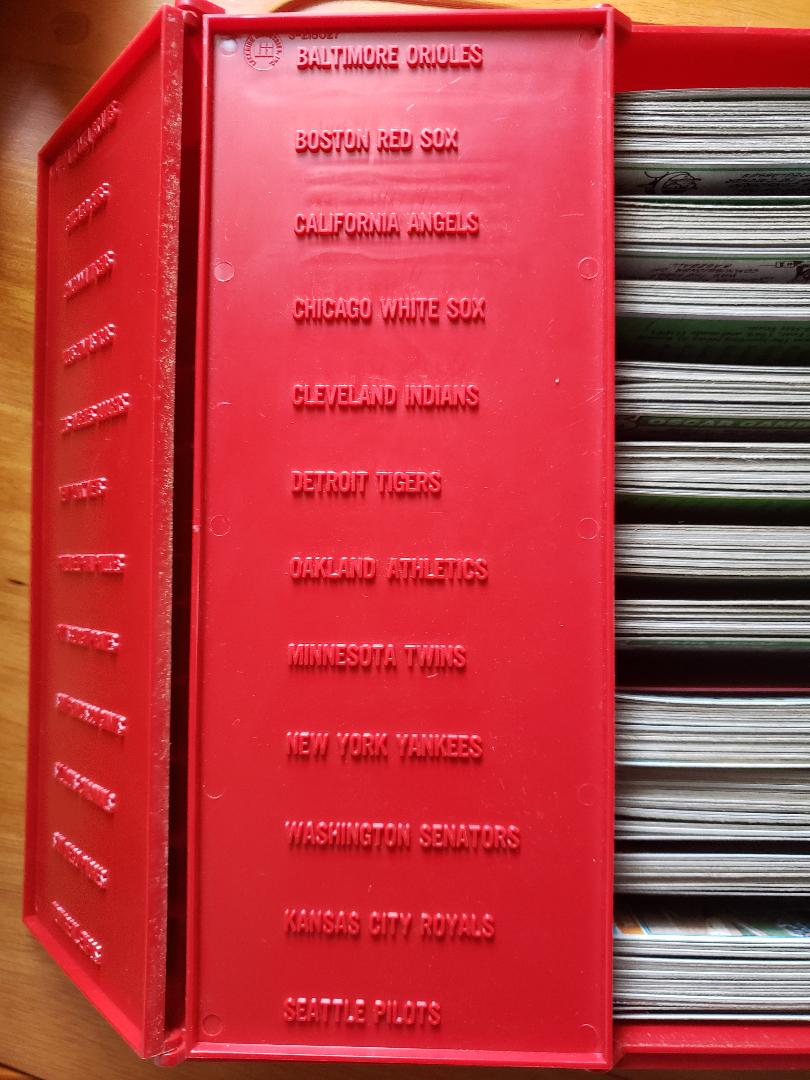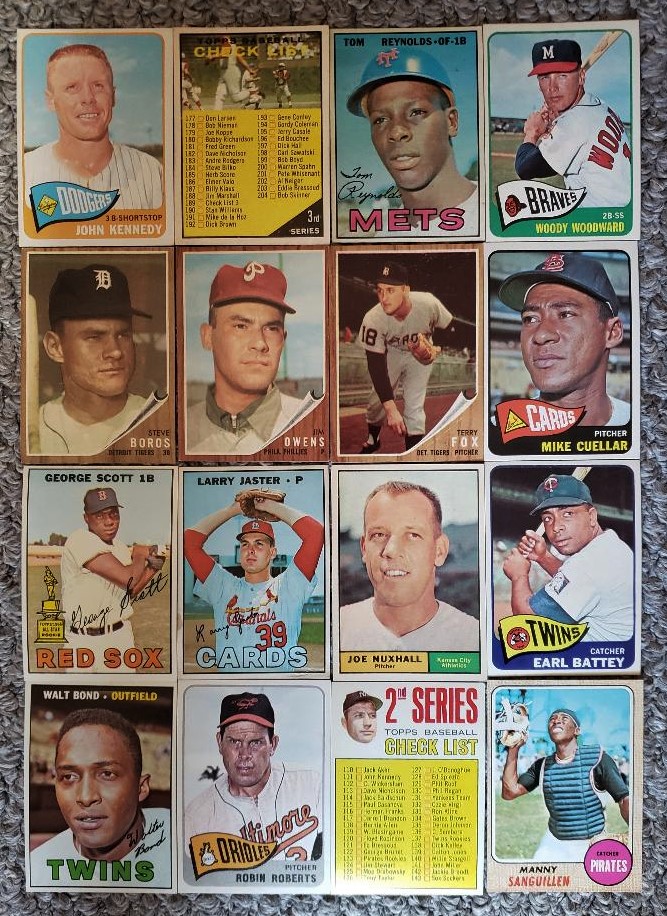Welcome to the Vintage Week finale.
So, just before I went on vacation last month, a work acquaintance was clearing out his childhood home, which is a few hours from here.
He uncovered his childhood card collection and, having no interest in collecting anymore, wondered if he could sell it. He knew I collected cards, based on the conversations I've had with the guy who works downstairs (the one who clears out store shelves and chats up the distributor). He asked if he could bring some of it in and I could gauge what he had.
Sure, I said. Because, here's the thing: he's older than me. This isn't one of those many people who was hoarding junk wax in the late '80s.
A couple days later he brought in several shopping bags with his collection in tow. Instantly, I was impressed. Almost all of the cards were from the 1960s and 1970s and they ran across all four major sports, baseball, football, basketball and hockey.
Before I go through the cards and sets, though, I'll get this out of the way. He had a bunch of these:
Those are unopened 3-pack "trays" of 1979 Topps. This is just a taste. He had more than FORTY of them.
With barely a glance of the other stuff in the bags, I told him those were the most valuable items he had and he could get thousands for them. Sell, sell, sell, I said. I'm baffled that people are able to keep stuff like this without ever opening it, but in hind-sight, man, is that ever the smart thing to do. Because you could line up 35 Ozzie Smith rookie cards from 1979 and it wouldn't pull in what these unopened packs would. People lose their minds for sealed wax.
He took my advice (I showed him on ebay what they were going for) and sold several of them at a "we buy cards" show that just happened to be in town that weekend. Fortunately he had talked to me first, so he wouldn't get swindled by these types. He stuck to his price and sold only a few of the trays there and then later found a couple of different hobby dealers around the state to buy the rest.
Now it was up to me to determine what else he had. I took the shopping bags with me on my vacation and evaluated when I had time. As you can imagine, it was a pure joy and not work at all.
This is a complete set of the 1976-77 Topps basketball set, aka, the "Tall Boy" set. The Dr. J. card at left is the most valuable card. You might be able to tell that the cards are pristine. That would be a running theme, and that Erving card is a $75 card, easy.
Of the NBA cards I saw, he had this set and much of the 1975-76 NBA set, as well as a few scattered NBA cards from earlier in the '70s. Almost all of the hockey cards were from the 1976-77 Topps set, including a couple Bryan Trottier rookies. Most of the football was from the 1977 Topps set -- it wasn't complete -- but there were also some older football cards, some from the '50s, a few of CFL players, and a few cards from those old Philadelphia sets from the early '60s, which I had never seen before. Most in perfect shape. Have you ever seen 1962 Topps football -- the one with black borders -- in almost mint shape? I did.
I did my best to approximate fair prices with those, although I'm less familiar with non-baseball stuff. But I knew he had good stuff. Unfortunately these were the cards that suffered the most from that old kid-sorting trick -- wrap everything in rubber bands. I saw first-hand what happens to card that are strangled by rubber bands for 50 years, stashed in a basement. He had three Bill Walton rookies. All of them damaged and warped by rubber bands.
But let's not dwell on that. Let's get to more immaculate stuff.
My eyes lit up when I saw this. Just wonderful. Yes, I've seen these cards many times over and have completed the set but it's been a long time -- if ever -- that I've seen these cards, that many of them, in direct-out-of-the-pack shape.
The entire set was here, with several duplicates:
Three Reggies.
Two Ryans.
Three Aarons. (There was just one Brett and Yount each).
I put these cards in penny sleeves, and some of them I put in top loaders. (There were a couple of Abdul-Jabbar cards I immediately threw into top loaders). These things were just naked in a box. He didn't really know what he had, even though he follows sports. Like many, he just stopped collecting as a kid, and stopped caring. He certainly didn't keep up with the hobby.
I mean this was how the cards were stored back then:
The old card locker! Advertised on wax wrappers back in the day! This goes back, note the Seattle Pilots listing. My friend said he began collecting cards in 1968.
You might be able to tell that the cards inside there are 1976 Topps. He had several other '76 Topps in a shoebox. I pulled the card locker ones out before more warping damage could occur and then sorted them all together.
The '76 set wasn't complete. Neither was the '77 Topps set, but he had most of those.
The '75 set was complete but all the checklists were marked and a couple of cards bit the dust due to rubber band attacks.
This is the entire 1972 Topps set, excluding the checklists, which were missing. Sharp corners all. And in perfect shape except for a couple of rubber band issues.
That includes the high numbers. There were DUPLICATES of high number cards.
Duplicates of the high-number Rod Carew In-Action card. Duplicates of the Jim Kaat high-number card. And these aren't the off-condition versions that I had to settle for when I was completing my set. Where was this guy when I was trying to track these down from all-too-knowing dealers?
It was amazing to go through all this. For years I've corresponded with fellow collectors who know all the cards but maybe don't have the means for perfection like this. Here was a person who had all of the perfection but didn't know the cards at all. I asked him if he knew years for the cards by looking at them, so when I made lists of what he had, he could size them up. "I knew them as a kid, but I don't know now," he said.
Crazy. And I would've lost my mind if I was trying to finish the '72 set when I saw these.
Here is a mint Joe Morgan rookie from 1965 Topps. He didn't have a lot of '60s cards prior to 1968 but the ones he did were in great shape (I think he might have gotten them from a fellow collector when he was a kid). There were a few other cards like this that I put in top loaders or card savers -- stuff like a 1963 Topps Carl Yastrzemski and a 1972 Kellogg's Roberto Clemente -- and made sure to tell him, the stuff that's inside plastic is SPECIAL.
I made lists of everything he had, year-by-year, and priced it the best I could, giving individual ballpark prices for the star cards and set prices for sets he had complete or close to complete.
I told him ebay was his best route, but being older I could tell he didn't want to deal with that, and I understand, it certainly is work-intensive. However, he found a couple of dealers in person and one of them has been to his old house a couple of times already.
He still has other cards back at the house that he hasn't found yet (he's quite sure he had most of the 1970 Topps baseball set but doesn't know where it is -- bummer, as that's a set I'm collecting).
He was very appreciative of the "work" that I did and although it was kind of a breeze for me, I think I was able to push him in the right directions and give him an idea of what he had. And therefore, there was some compensation involved.
Here is some of it:
A nice mix of '60s needs there. I'm sure you spotted the '67 Steve Carlton and the unmarked '67 checklist with the Mantle head. I'm really happy I don't have to chase that down from some dealer who enacts the Mantle-Floating-Head Tax.
I also gave him some money for some cards from a couple of different sets. I admit, I had a hard time choosing exactly what I wanted, although my choices were nicely narrowed by having completed some of them.
Here's a 1972 Kellogg's quartet that I now own, three Hall of Famers and Merv.
The rest of the cards came from a single other set:
I've landed 116 cards from 1969 Topps.
This has always been a clandestine set-build for me. I've been quietly accumulating cards from it because while there are plenty of "issues" with the set, it's one of those "old sets" that I saw when I was a kid, so I keep gravitating toward it.
This large chunk of cards from '69 boosted me from having around 50 percent of the set to 68 percent! Geez, I think I'm officially officially collecting it now, and I can no longer have a binder that shares both the '69 and '70 sets!
All the tell-tale signs of 1969 were in this stack.
The blacked-out hats.
The haircuts.
And the notables.
The '68 and '69 sets were the first ones he collected so there's a little bit of wear (tape and such) on just a few cards (I see he also cut up some of the cards into "mini cards" as I did when I was a kid).
I snagged about half of the '69 cards and left the other half. There was no Bench or Ryan or Jackson in his collection or then I'd have real decisions to make.
So, yeah, part of me would like to be in my work friend's shoes. He's made some money and he's got more to make, although it will probably take awhile. I told him to keep me updated and ask any other questions. I don't want him to get taken but I think he's well-enough aware now (he's determined to find that '70 set because I said the Ryan -- especially if it's in sparking shape -- will go for a good chunk).
I probably will never come across another stash like this to wander through again. It sure was fun. And it was nice to remember the days when we wrapped our cards in rubber bands and stuffed them in a shoebox.
Although I apparently played with them a lot more than he did.
Maybe a bad decision on my part.



















Comments
If that were me, I would have been over the moon to help out someone get the max value for their collection. And it looks like you were handsomely compensated for your time. A win-win if I ever saw one.
I never had a card locker like that, but I have four cardboard boxes with similar functions. They have little dividers and the boxes came with labels for them. Most of my early-80s cards which aren't Mets and aren't worth putting in binders are in there.